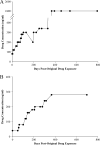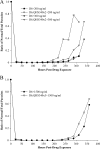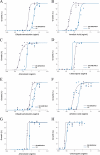Phenotypic and genotypic analysis of in vitro-selected artemisinin-resistant progeny of Plasmodium falciparum
- PMID: 22083467
- PMCID: PMC3256069
- DOI: 10.1128/AAC.05540-11
Phenotypic and genotypic analysis of in vitro-selected artemisinin-resistant progeny of Plasmodium falciparum
Abstract
Emergence of artemisinin resistance in Cambodia highlights the importance of characterizing resistance to this class of drugs. Previously, intermediate levels of resistance in Plasmodium falciparum were generated in vitro for artelinic acid (AL) and artemisinin (QHS). Here we expanded on earlier selection efforts to produce levels of clinically relevant concentrations, and the resulting lines were characterized genotypically and phenotypically. Recrudescence assays determined the ability of resistant and parent lines to recover following exposure to clinically relevant levels of drugs. Interestingly, the parent clone (D6) tolerated up to 1,500 ng/ml QHS, but the resistant parasite, D6.QHS340×3, recovered following exposure to 2,400 ng/ml QHS. Resistant D6, W2, and TM91c235 parasites all exhibited elevated 50% inhibitory concentrations (IC(50)s) to multiple artemisinin drugs, with >3-fold resistance to QHS and AL; however, the degree of resistance obtained with standard methods was remarkably less than expected for parasite lines that recovered from 2,400-ng/ml drug pressure. A novel assay format with radiolabeled hypoxanthine demonstrated a greater degree of resistance in vitro than the standard SYBR green method. Analysis of merozoite number in resistant parasites found D6 and TM91c235 resistant progeny had significantly fewer merozoites than parent strains, whereas W2 resistant progeny had significantly more. Amplification of pfmdr1 increased proportionately to the increased drug levels tolerated by W2 and TM91c235, but not in resistant D6. In summary, we define the artemisinin resistance phenotype as a decrease in susceptibility to artemisinins along with the ability to recover from drug-induced dormancy following supraclinical concentrations of the drug.
Figures







Similar articles
-
Role of pfmdr1 amplification and expression in induction of resistance to artemisinin derivatives in Plasmodium falciparum.Antimicrob Agents Chemother. 2010 Jun;54(6):2455-64. doi: 10.1128/AAC.00947-09. Epub 2010 Mar 29. Antimicrob Agents Chemother. 2010. PMID: 20350946 Free PMC article.
-
In vitro selection of Plasmodium falciparum Pfcrt and Pfmdr1 variants by artemisinin.Malar J. 2016 Jul 22;15(1):381. doi: 10.1186/s12936-016-1443-y. Malar J. 2016. PMID: 27449110 Free PMC article.
-
Phenotypic changes in artemisinin-resistant Plasmodium falciparum lines in vitro: evidence for decreased sensitivity to dormancy and growth inhibition.Antimicrob Agents Chemother. 2012 Jan;56(1):428-31. doi: 10.1128/AAC.05456-11. Epub 2011 Oct 10. Antimicrob Agents Chemother. 2012. PMID: 21986828 Free PMC article.
-
pfmdr1 (Plasmodium falciparum multidrug drug resistance gene 1): a pivotal factor in malaria resistance to artemisinin combination therapies.Expert Rev Anti Infect Ther. 2017 Jun;15(6):527-543. doi: 10.1080/14787210.2017.1313703. Epub 2017 Apr 10. Expert Rev Anti Infect Ther. 2017. PMID: 28355493 Review.
-
How genomics is contributing to the fight against artemisinin-resistant malaria parasites.Acta Trop. 2015 Aug;148:1-7. doi: 10.1016/j.actatropica.2015.04.007. Epub 2015 Apr 21. Acta Trop. 2015. PMID: 25910626 Review.
Cited by
-
Artemisinin resistance in Plasmodium falciparum: A process linked to dormancy?Int J Parasitol Drugs Drug Resist. 2012 Dec 1;2:249-255. doi: 10.1016/j.ijpddr.2012.01.001. Epub 2012 Jan 27. Int J Parasitol Drugs Drug Resist. 2012. PMID: 23420506 Free PMC article.
-
Comparison of the Exposure Time Dependence of the Activities of Synthetic Ozonide Antimalarials and Dihydroartemisinin against K13 Wild-Type and Mutant Plasmodium falciparum Strains.Antimicrob Agents Chemother. 2016 Jul 22;60(8):4501-10. doi: 10.1128/AAC.00574-16. Print 2016 Aug. Antimicrob Agents Chemother. 2016. PMID: 27161632 Free PMC article.
-
The Novel bis-1,2,4-Triazine MIPS-0004373 Demonstrates Rapid and Potent Activity against All Blood Stages of the Malaria Parasite.Antimicrob Agents Chemother. 2021 Oct 18;65(11):e0031121. doi: 10.1128/AAC.00311-21. Epub 2021 Aug 30. Antimicrob Agents Chemother. 2021. PMID: 34460304 Free PMC article.
-
Inhibiting the Plasmodium eIF2α Kinase PK4 Prevents Artemisinin-Induced Latency.Cell Host Microbe. 2017 Dec 13;22(6):766-776.e4. doi: 10.1016/j.chom.2017.11.005. Cell Host Microbe. 2017. PMID: 29241041 Free PMC article.
-
A novel flow cytometric hemozoin detection assay for real-time sensitivity testing of Plasmodium falciparum.PLoS One. 2013 Apr 24;8(4):e61606. doi: 10.1371/journal.pone.0061606. Print 2013. PLoS One. 2013. PMID: 23637865 Free PMC article.
References
-
- Alker AP, et al. 2007. pfmdr1 and in vivo resistance to artesunate-mefloquine in falciparum malaria on the Cambodian-Thai border. Am. J. Trop. Med. Hyg. 76:641–647 - PubMed
Publication types
MeSH terms
Substances
Grants and funding
LinkOut - more resources
Full Text Sources

